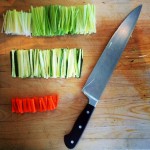 Going out to eat is one of life’s little pleasures common to so many people. Trying out a new hot spot or visiting a favorite restaurant where you’re treated like family is a big part of the fun of dining out. It’s often a welcome relief from cooking and cleaning up afterwards and also a great way to socialize with friends or have a fun night out with the entire family. Dining out has so many great benefits associated with it that we often overlook some of the pitfalls it can present towards staying on track with a healthy eating regimen. These pitfalls are greatly magnified when attempting to stick to a low carb eating plan.
Going out to eat is one of life’s little pleasures common to so many people. Trying out a new hot spot or visiting a favorite restaurant where you’re treated like family is a big part of the fun of dining out. It’s often a welcome relief from cooking and cleaning up afterwards and also a great way to socialize with friends or have a fun night out with the entire family. Dining out has so many great benefits associated with it that we often overlook some of the pitfalls it can present towards staying on track with a healthy eating regimen. These pitfalls are greatly magnified when attempting to stick to a low carb eating plan.
I’m going to cut right to the chase and get the unpleasant stuff out of the way before we go any further and that’s my belief that you should severely limit the number of meals you eat away from home. OK, let that sink in a bit and also give me a chance to duck while you hurl the nearest piece of furniture in my general direction once you’ve fully absorbed the outrageousness of my position.
I have nothing against the dining industry and some of the nicest clients in my marketing consulting business happen to be restaurant owners. The last thing I wish to see is their businesses hurt because diners have decided to eat all their meals at home, however, that’s never going to happen no matter how much I preach about the importance of preparing your own food. Restaurant proprietors the world over can now breathe a big sigh of relief!
My fundamental point is that you should make a serious effort to eat more of your meals at home especially if you’re eating more than three meals a week out. This may be you if you’re single and don’t feel like staying home and cooking or if you’re older and your kids have left home and you don’t see the point in cooking for just two every night.
There are strategies for dealing with these situations that I’ll cover in future articles, but for now, let’s have a look at several strategies for restaurant and menu selection when you do find yourself eating meals away from home.
We will need to have a look at several factors:
- Which meal(s) are you eating out: breakfast, lunch, or dinner
- Restaurant type and cuisine
- Menu selections
First off, when it comes to which meals you’re eating away from home, you should never eat breakfast out. Traveling is a special case and there’s not much you can do about it since you will be eating most all of your meals either in hotels or restaurants unless you’re lucky enough to be visiting with friends or relatives.
I used to be guilty of stopping off at McDonald’s or Roy Rogers (fast food place in MD known for their breakfast biscuits) almost every weekday before heading into the office. It wasn’t so much that I didn’t have time to fix breakfast at home as I was addicted to sausage, egg, and cheese biscuits with a side of hash browns and an over-sweetened cup of coffee.
It was a special treat that got my day off to a happy start and it was a very difficult routine to break, but one that was expanding my waistline and raising my cholesterol levels. If you’re going to eat breakfast out, then really make an effort to limit it to just one day per week and try to resist the temptation of going full-on “Grand Slam” with lots of pancakes, waffles, and syrup! It’s far better to just have a light breakfast at home along with your first cup of coffee or tea. I’ll have a whole lot more to say about breakfast in future articles.
Eating lunch out is probably the biggest pitfall for anyone who works outside their home – both in terms of excess calories consumed and extra dollars spent. Eating lunch out more than once a week can get expensive in a hurry. At least when compared to preparing your own meals. And when it comes to the establishments that most workers tend to frequent, they are usually of the “fast food” variety. It may come as a shock, but eating foot long subs every day for lunch won’t decrease your pants size no matter what that guy on TV says.
So what kinds of restaurants are going to be the friendliest to your health and waistline?
Since that’s a tough question, let me start with the kinds of places that are the worst. I’d have to say, that after the burger and fried chicken joints, that Chinese restaurants are a very close second – especially the ones with the “Big Buffet.” Even though Chinese dishes tend to have a lot of vegetables in them, the breading and super sweet sauces they come drenched in won’t do you any favors. The best approach is to skip all the appetizers (yes, I know, they’re the best part) and order a small lunch sized entrée. Just be sure to ask if they can bring a “brown sauce” on the side so you can portion it out yourself (they’ll know what you mean) and don’t consume the entire bowl of rice that comes with it. You also don’t have to eat the entire plate as Chinese food makes for some great leftovers.
BBQ and chicken places, as tasty as their offerings are, should be avoided. The thick and sweet sauces on BBQ and the breading on chicken along with the starchy sides such as fries, mashed potatoes, mac and cheese, and buttermilk biscuits are waistline killers. Unfortunately, that last sentence just made my mouth water – ugh!
Italian restaurants are a mixed bag and can actually provide some healthy, low carb options if you’re careful. It’s staying away from the bread basket, the wide variety of tempting pastas, and the pizza that makes going Italian a real challenge. However, if you don’t succumb to the aforementioned temptations, there are plenty of seafood dishes, especially fish, as well as veal and chicken dishes that are both tasty and low carb. Just avoid the parmigiana versions which have a lot of breading and instead of the typical side of pasta, ask for whatever the fresh vegetable of the day is. A small side salad with oil and vinegar or vinaigrette dressing is a great starter – just try your best to stay away from the warm Italian bread and butter!
Perhaps the best types of places to have a meal out are the chain “family style” restaurants such as Places like Ruby Tuesday, Chili’s, TGI Friday, etc. Steak houses are also good choices, but they are typically quite a bit more expensive. Of course, you can certainly go off the rails easily at these places as well, but with all the menu selections they offer, it’s not too difficult to find something on the low carb side.
Steaks, chicken, fish, and vegetarian offerings are all good places to start. As with Italian cuisine, just be sure to watch the appetizers and sides. Veggies are always the preferred side dish and don’t be afraid to ask your server to hold the fries, pasta, rice, or potatoes and substitute a vegetable side such as steamed broccoli or roasted carrots. If the restaurant has a salad bar, so much the better, just don’t load your plate up with macaroni salad and potato salad and avoid the overly sweet dressings such as honey mustard and French dressings. Ordering a small house salad and using the same discretion regarding dressings is a good choice in other establishments sans salad bar.
This now brings us to dessert.
What, you didn’t think I was going to advise you to avoid dessert entirely while your dining companions indulge themselves did you?
No way!
When I choose to dine out, I want it to be a special treat and that definitely includes treating myself to dessert. Dessert in the traditional sense of cake, ice cream, or other decadent delights is something I rarely have when I eat at home. Therefore, when I’m dining out I make sure that the rest of the meal, from the appetizer through the entrée, is as healthy and low carb as I can make it. I’m then free to have some double chocolate cake or Key Lime pie along with my coffee!
The main thing to consider is that for the sake of your health and your waistline, it’s far easier to control what you eat if you plan and prepare your own meals. Eating out should be approached as a special treat – not as part of your everyday routine. Taking this measured approach, and ordering your meal with a game plan at the ready, is the best recipe for a healthy and enjoyable dining out experience!



Leave a Reply